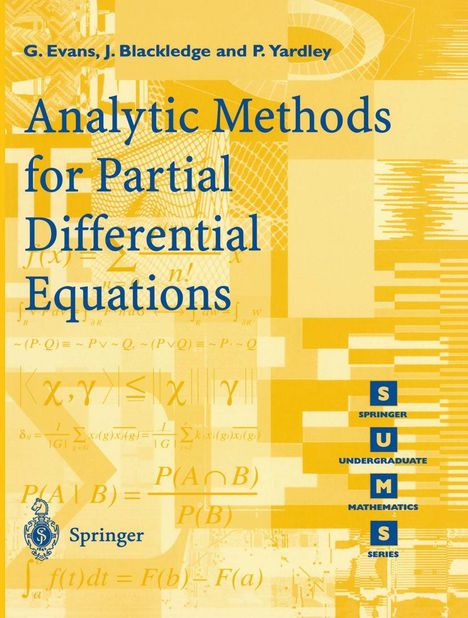G. Evans: Analytic Methods for Partial Differential Equations, Kartoniert / Broschiert
Analytic Methods for Partial Differential Equations
(soweit verfügbar beim Lieferanten)
- Verlag:
- Springer London, 11/1999
- Einband:
- Kartoniert / Broschiert, Paperback
- Sprache:
- Englisch
- ISBN-13:
- 9783540761242
- Artikelnummer:
- 7677966
- Umfang:
- 316 Seiten
- Sonstiges:
- XII, 299 pp. 25 figs.
- Nummer der Auflage:
- 1999
- Ausgabe:
- 1999
- Copyright-Jahr:
- 2000
- Gewicht:
- 553 g
- Maße:
- 235 x 178 mm
- Stärke:
- 17 mm
- Erscheinungstermin:
- 1.11.1999
- Hinweis
-
Achtung: Artikel ist nicht in deutscher Sprache!
Beschreibung
The subject of partial differential equations holds an exciting place in mathematics. At one extreme the interest lies in the existence and uniqueness of solutions, and the functional analysis of the proofs of these properties. At the other extreme lies the applied mathematical and engineering quest to find useful solutions, either analytically or numerically, to these important equations which can be used in design and construction. The objective of this book is to actually solve equations rather than discuss the theoretical properties of their solutions. The topics are approached practically, without losing track of the underlying mathematical foundations of the subject. The topics covered include the separation of variables, the characteristic method, D'Alembert's method, integral transforms and Green's functions. Numerous exercises are provided as an integral part of the learning process, with solutions provided in a substantial appendix.Inhaltsangabe
1. Mathematical Preliminaries.- 1.1 Introduction.- 1.2 Characteristics and Classification.- 1.3 Orthogonal Functions.- 1.4 Sturm-Liouville Boundary Value Problems.- 1.5 Legendre Polynomials.- 1.6 Bessel Functions.- 1.7 Results from Complex Analysis.- 1.8 Generalised Functions and the Delta Function.- 1.8.1 Definition and Properties of a Generalised Function.- 1.8.2 Differentiation Across Discontinuities.- 1.8.3 The Fourier Transform of Generalised Functions.- 1.8.4 Convolution of Generalised Functions.- 1.8.5 The Discrete Representation of the Delta Function.- 2. Separation of the Variables.- 2.1 Introduction.- 2.2 The Wave Equation.- 2.3 The Heat Equation.- 2.4 Laplace s Equation.- 2.5 Homogeneous and Non-homogeneous Boundary Conditions.- 2.6 Separation of variables in other coordinate systems.- 3. First-order Equations and Hyperbolic Second-order Equations.- 3.1 Introduction.- 3.2 First-order equations.- 3.3 Introduction to d Alembert s Method.- 3.4 d Alembert s General Solution.- 3.5 Characteristics.- 3.6 Semi-infinite Strings.- 4. Integral Transforms.- 4.1 Introduction.- 4.2 Fourier Integrals.- 4.3 Application to the Heat Equation.- 4.4 Fourier Sine and Cosine Transforms.- 4.5 General Fourier Transforms.- 4.6 Laplace transform.- 4.7 Inverting Laplace Transforms.- 4.8 Standard Transforms.- 4.9 Use of Laplace Transforms to Solve Partial Differential Equations.- 5. Green s Functions.- 5.1 Introduction.- 5.2 Green s Functions for the Time-independent Wave Equation.- 5.3 Green s Function Solution to the Three-dimensional Inhomogeneous Wave Equation.- 5.4 Green s Function Solutions to the Inhomogeneous Helmholtz and Schrödinger Equations: An Introduction to Scattering Theory.- 5.5 Green s Function Solution to Maxwell s Equations and Time-dependent Problems.- 5.6 Green s Functions and Optics: Kirchhoff Diffraction Theory.- 5.7 Approximation Methods and the Born Series.- 5.8 Green s Function Solution to the Diffusion Equation.- 5.9 Green s Function Solution to the Laplace and Poisson Equations.- 5.10 Discussion.- A. Solutions of Exercises.Klappentext
The subject of partial differential equations holds an exciting and special position in mathematics. Partial differential equations were not consciously created as a subject but emerged in the 18th century as ordinary differential equations failed to describe the physical principles being studied. The subject was originally developed by the major names of mathematics, in particular, Leonard Euler and Joseph-Louis Lagrange who studied waves on strings; Daniel Bernoulli and Euler who considered potential theory, with later developments by Adrien-Marie Legendre and Pierre-Simon Laplace; and Joseph Fourier's famous work on series expansions for the heat equation. Many of the greatest advances in modern science have been based on discovering the underlying partial differential equation for the process in question. J ames Clerk Maxwell, for example, put electricity and magnetism into a unified theory by estab lishing Maxwell's equations for electromagnetic theory, which gave solutions for problems in radio wave propagation, the diffraction of light and X-ray developments. Schrodinger's equation for quantum mechankal processes at the atomic level leads to experimentally verifiable results which have changed the face of atomic physics and chemistry in the 20th century. In fluid mechanics, the Navier-Stokes' equations form a basis for huge number-crunching activities associated with such widely disparate topics as weather forcasting and the design of supersonic aircraft. Inevitably the study of partial differential equations is a large undertaking, and falls into several areas of mathematics.


